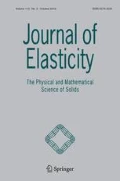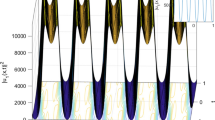Abstract
We derive a one-dimensional model for the displacement and torsion of an elastic string starting from a cylindrical three-dimensional linearized prestressed elastic body with small diameter. The prestress is due to the prior elastic deformation of an isotropic, homogenous, elastic body. We deduce the scaling of forces by a formal asymptotic expansion. Then we prove that the family of solutions of three-dimensional problems converges to a limit that is the unique solution of the string model. Coefficients of the string model depend on the three-dimensional elasticity coefficients and the tension due to the predeformation.
Similar content being viewed by others
References
Acerbi, E., Buttazzo, G., Percivale, D.: A variational definition of the strain energy for an elastic string. J. Elast. 25, 137–148 (1991)
Ciarlet, P.G.: Mathematical Elasticity, Vol I: Three-Dimensional Elasticity. North-Holland, Amsterdam (1988)
Ciarlet, P.G.: Mathematical Elasticity, Vol II: Theory of Plates. North-Holland, Amsterdam (1997)
Ciarlet, P.G.: Mathematical Elasticity, Vol III: Theory of Shells. North-Holland, Amsterdam (2000)
Della Longa, L., Londero, A.: Thin walled beams with residual stress. J. Elast. 96, 27–41 (2009)
Friesecke, G., James, R.D., Müller, S.: A theorem on geometric rigidity and the derivation of nonlinear plate theory from three-dimensional elasticity. Commun. Pure Appl. Math. 55, 1461–1506 (2002)
Friesecke, G., James, R.D., Müller, S.: A hierarchy of plate models derived from nonlinear elasticity by Γ-convergence. Arch. Ration. Mech. Anal. 180, 183–236 (2006)
Hoger, A.: On the determination of residual stress in an elastic body. J. Elast. 16, 303–324 (1986)
Irago, H., Viaño, J.M.: Error estimation in the Bernoulli–Navier model for elastic rods. Asymptot. Anal. 21, 71–87 (1999)
Johnson, B.E., Hoger, A.: The dependence of the elasticity tensor on residual stress. J. Elast. 33, 145–165 (1993)
Jurak, M., Tambača, J.: Derivation and justification of a curved rod model. Math. Models Methods Appl. Sci. 9, 991–1014 (1999)
Le Dret, H., Raoult, A.: The nonlinear membrane model as variational limit of nonlinear three-dimensional elasticity. J. Math. Pures Appl. 74, 549–578 (1995)
Lewicka, M., Pakzad, M.R.: Scaling laws for non-Euclidean plates and the W 2,2 isometric immersions of Riemannian metrics. ESAIM: Control Optim. Calc. Var. 17, 1158–1173 (2011)
Lewicka, M., Mahadevan, L., Pakzad, M.R.: The Foppl-von Karman equations for plates with incompatible strains. Proc. R. Soc. A 467, 402–426 (2011)
Marigo, J.J., Meunier, N.: Hierarchy of one-dimensional models in nonlinear elasticity. J. Elast. 83, 1–28 (2006)
Miara, B.: Justification of the asymptotic analysis of elastic plates, I: the linear case. Asymptot. Anal. 9, 47–60 (1994)
Mora, M.G., Müller, S.: Derivation of the nonlinear bending-torsion theory for inextensible rods by Γ-convergence. Calc. Var. Partial Differ. Equ. 18, 287–305 (2003)
Mora, M.G., Müller, S.: A nonlinear model for inextensible rods as a low energy Γ-limit of three-dimensional nonlinear elasticity. Ann. Inst. Henri Poincaré, Anal. Non Linéaire 21, 271–293 (2004)
Mora, M.G., Müller, S., Schultz, M.G.: Convergence of equilibria of planar thin elastic beams. Indiana Univ. Math. J. 56, 2413–2438 (2007)
Nečas, J., Hlaváček, I.: Mathematical Theory of Elastic and Elasto-Plastic Bodies: an Introduction. Elsevier, Amsterdam (1980)
Paroni, R.: Theory of linearly elastic residually stressed plates. Math. Mech. Solids 11, 137–159 (2006)
Paroni, R.: The equations of motion of a plate with residual stress. Meccanica 41, 1–21 (2006)
Truesdell, C.: A First Course in Rational Continuum Mechanics. Springer, New York (1967)
Trabucho, L., Viaño, J.M.: Mathematical Modelling of Rods. Handbook of Numerical Analysis, vol. 4, pp. 487–974 (1996)
Tutek, Z., Aganović, I.: A justification of the one-dimensional linear model of elastic beam. Math. Methods Appl. Sci. 8, 1–14 (1986)
Author information
Authors and Affiliations
Corresponding author
Rights and permissions
About this article
Cite this article
Marohnić, M., Tambača, J. Derivation of the Linear Elastic String Model from Three-Dimensional Elasticity. J Elast 111, 41–65 (2013). https://doi.org/10.1007/s10659-012-9394-1
Received:
Published:
Issue Date:
DOI: https://doi.org/10.1007/s10659-012-9394-1




